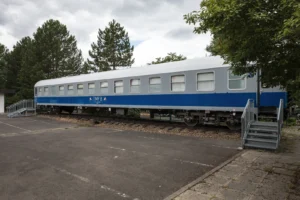Where else but in Berlin can you find the city’s busiest square and still, with good reason, describe it as «off the beaten path?»
Berlin´s busiest Square, but off the beaten Path
The city’s Alexanderplatz fits this odd description perfectly. It’s Berlin’s largest and busiest square and yet most visitors don’t quite know what to make of it. If they go there at all, they tend to take a quick glance, write it off as modern and ugly, and head off in search of something older and more picturesque. But this would be a mistake, because this busy platz, or town square, becomes increasingly more interesting the more you get to know it.
A Nondescript Railway Bridge?
Let’s begin our quick tour round the square by the railway bridge next to the Alexanderplatz train station. Head under the bridge and come out into the square itself, but don’t go far. Instead, turn back and look at the bridge once again.
The rail lines have crossed this place here for well over 150 years and have thus been witness to Berlin’s history in all its dark tumult. But the story is deeper than that. The tracks you see here were built on the site of the moat of the medieval wall. The street and the bridge mark the spot where one of the old town’s earliest gates once stood. So when you walked under the bridge, you were walking out of the old town and into the area just outside the walls, today’s Alexanderplatz. This gate also played host to the gibbets, where executed criminals were once displayed as a warning to others.
The Place got its Name after the Russian Tsar Alexander 1 who helped drive the French out of Berlin
Now that you’re in the square, it’s worth asking just where the name of the place came from. Which Alexander is being honored here? Turns out it’s not Alexander the Great, but rather the Russian Tsar-Emperor Alexander I, who helped drive the French out of Berlin following Napoleon’s failed invasion of the Russian Empire in 1812. The Russian leader and his entourage gathered here before making their triumphal entry into the city through that gate that once stood where the railway bridge is now.

The World Clock, Pride of the Communist DDR State
Look now back into the square, and take note of that oddly futuristic object ahead. This is the former East Berlin’s famous «World Clock,» which opened in 1969 and which shows the time in 146 places around the world. The great irony, of course, is that vanishingly few of the Communist state’s citizens could visit any of those places, having to console themselves with merely knowing the time. Sitting on top of the clock is a representation of the solar system.
Go around the clock and turn around, putting the clock itself, along with the TV tower and the edge of the train station in your camera lens. This view was once of the most famous in the communist world in the 1970s and 80s, repeated in endless images. The TV tower and the World Clock were both opened in 1969 and both celebrate the birth of a new world in which science, rationality and the march of progress upward to space and through time to the «radiant future» are the dominant themes. The old world, with its outdated ideas, was buried here, literally and symbolically. The image you have in your camera now was the embodiment of what East Germany’s communist ruler saw as being the best of what their dreams represented.
The World Clock – DDR Pride – But also a Hunting Ground for Stasi
However, there was a darker side. Of course there was, it was East Germany after all. The clock was by a considerable margin the most popular meeting place in the entire city. This itself created issues, for the logical reason that if everybody agreed to meet there, the ensuing crowds made actually finding your partner exponentially harder. But all these people meeting in once place made this a rich hunting ground for the Stasi, as the Secret Police was known.
They hung out and mingled in the crowds, in plainclothes but often carrying a briefcase or bag in which a recording device was hidden, looking for subversive chat. East Germans knew this, of course, but still met their friends there anyway. To me, few things capture the essence of East German life better. Joy at meeting friends, surrounded by the architecture of optimism, yet knowingly under strict surveillance, to ensure conformity and compliance. When you look at the carefree crowds today gathered in the place to listen to street musicians, the contrast is striking.
The Great Survivors: The Alexander Haus and the Berolina Haus
Now take a few steps further back from the World Clock, to get a bit away from the swirling crowds. You will now clearly see two communist looking buildings to your left and right, almost framing the World Clock. Appearances can deceive however, for these two buildings are not the product of Erich Honecker’s government, but are the Alexanderplatz’s great survivors. Dating from around 1930, the building on your right, across from the main body of the train station, is the Berolina Haus, and the L-shaped building to your left is its companion, the Alexander Haus.
«New Objectivity» – Architecture You meet at Alexanderplatz and elsewhere in Berlin
These two structures, designed by the famed architect Peter Behrens, are in a style of architecture called New Objectivity, which was all the rage in the era. It was essentially a reaction against the sensuality of Art Nouveau and placed emphasis on rationality, cubic forms and (often) vertical lines.
The buildings were both used as offices, but both have an odd connection to fast food. Starting from the mid-1950s, on the ground floor of the Berolina Haus, the DDR opened it’s own fast food restaurant. It took the form of vending machines, and users had to first buy tokens from cashiers located near the machines. It was a popular place in the otherwise rather austere era.
In the ground and first floor of the Alexander Haus was located the main branch of the legendary Berlin eatery Aschinger’s. In the 1920s to 1940s, this was an incredibly popular place to grab a quick bite to eat. Unexpectedly richly decorated, the chain specialized in good quality, cheap, food, including sausages, sauerkraut and local beers which could be consumed by the busy locals almost on-the-go. Fast food, before the term. Today, you can pay homage to these lost dining establishments by grabbing a quick bite from the modern versions you see scattered in the buildings today.
Before we head off, it might be of interest to know that the Berolina Haus, due to its being relatively lightly damaged in the war, was commandeered by the Soviet Red Army during the early years of their occupation of the city, and used as one of their headquarters. Nothing of this episode remains, and nothing is posted to inform you about it. Which is yet another good example of how cities choose to shape and form their narrative of their own past. What stories are told and which neglected tells you a great deal about the nature of the politics alive and active today.
Join us in the next entry as we dive deeper into the hidden stories of this fascinating, yet often overlooked square. There’s much more to uncover! As so often in Berlin, it’s the stories hiding in plain sight that prove to be the most interesting.
You can read
Alexanderplatz: From DDR Pride to Modern Consumerism (2)



